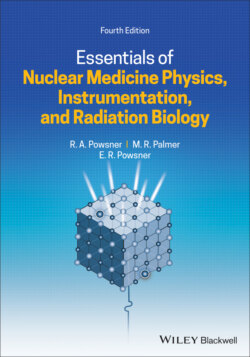Читать книгу Essentials of Nuclear Medicine Physics, Instrumentation, and Radiation Biology - Rachel A. Powsner - Страница 47
Half‐value and tenth‐value layers
ОглавлениеA material’s effectiveness as a photon attenuator is described by the attenuation coefficient. An alternative descriptor, one that is the more easily visualized, is the “half‐value layer” (HVL) which is simply the thickness of a slab of the attenuator that will remove exactly one half of the radiation of a beam. A second slab of the same thickness will remove half of the remainder (see comment below regarding monoenergetic beams), leaving one quarter of the original beam, and so forth. For a gamma photon of 100 keV, the HVL in soft tissue is about 4 cm [1].
Table 2.1 Predominant photon interactions in common materials at diagnostic energies
| Material | Atomic number (Z) | Density (gm/cm3) | Predominant interaction |
|---|---|---|---|
| H2O | 7.4 | 1.0 | Compton scatter |
| Soft tissue | 7.5 | 1.0 | Compton scatter |
| Glass (silicon) | 14 | 2.6 | Compton scatter |
| O2 (gas) | 16 | 0.0014 | Compton scatter |
| NaI (crystal) | 32 | 3.7 | Photoelectric effect |
| Lead | 82 | 11.4 | Photoelectric effect |
| Leaded glass | 14, 82 | 4.8–6.2 | Photoelectric effect |
For any attenuator the HVL can be determined experimentally using a photon source and a suitable detector. For calculations involving attenuation of high‐intensity radiation beams, an entirely similar concept, the tenth‐value layer (TVL), is useful. The TVL is the thickness of the attenuator that will transmit only one tenth of the photons in the beam. For a monoenergetic beam (containing photons of identical energies) directed at a material, two such thicknesses will transmit only one hundredth of the beam. If, however, the beam contains photons of different energies this rule is not applicable (see text box on beam hardening).
Figure 2.5 Attenuation.
Table 2.2 lists half and tenth value layer of lead for photons emitted by some common medical radionuclides.
For a monoenergetic beam of photons, the linear attenuation coefficient, μ, is related to the HVL as follows:
